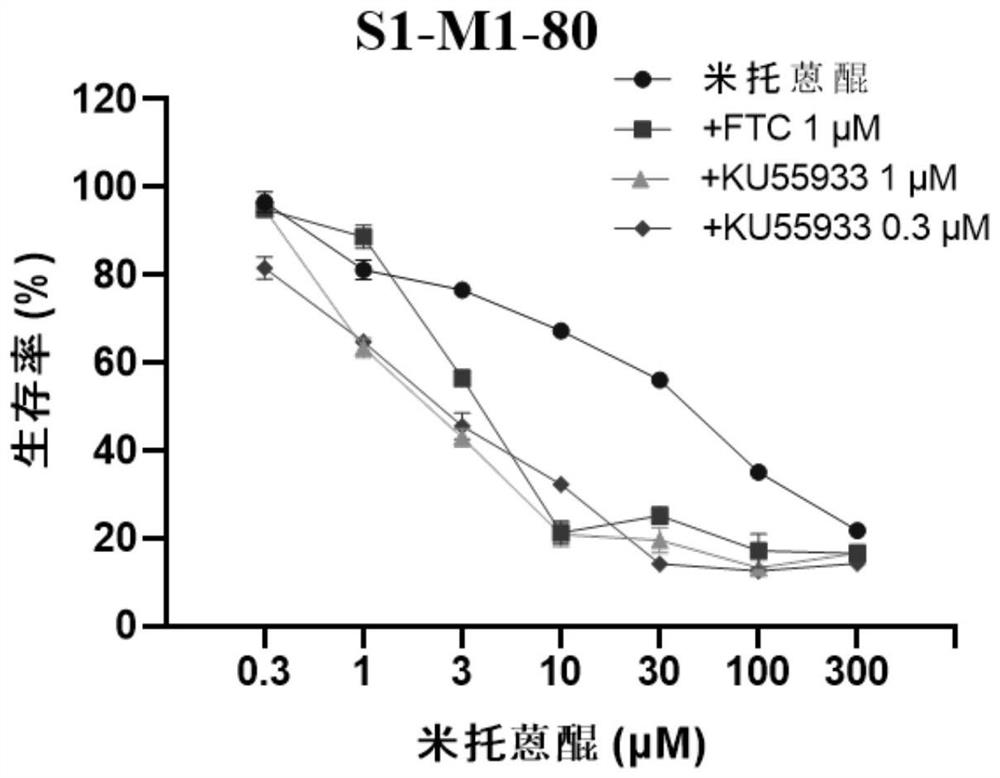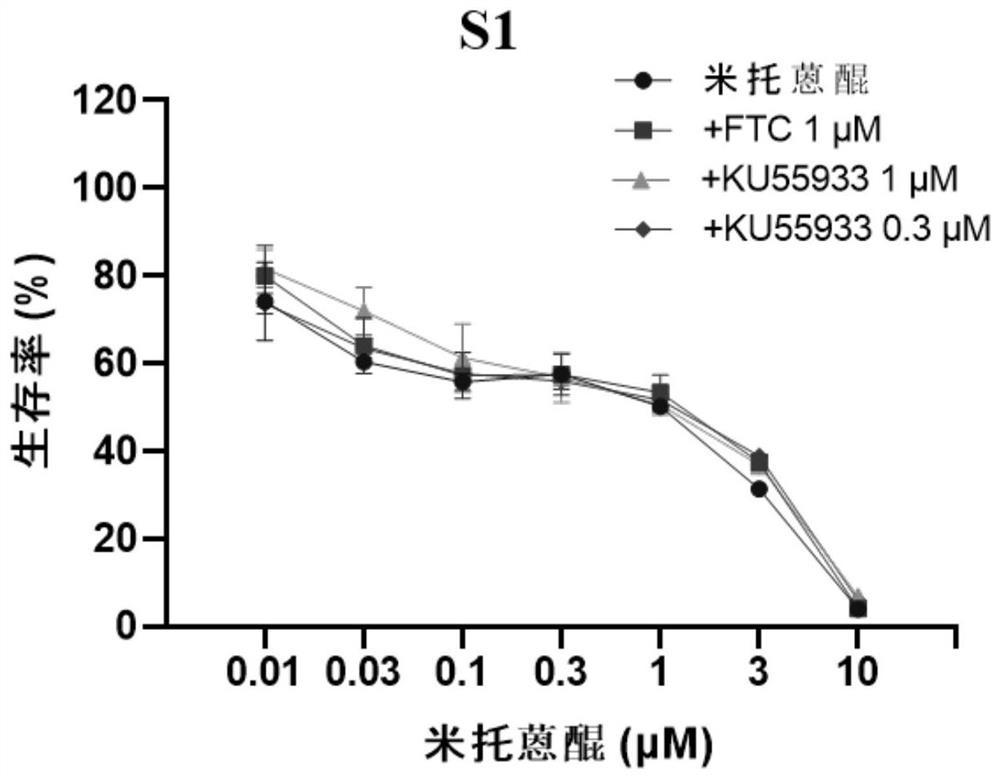Application of KU55933 in preparation of drugs for reversing multidrug resistance of tumor
A multi-drug resistance and drug technology, applied in antineoplastic drugs, drug combinations, pharmaceutical formulations, etc., can solve the problems of function loss, poor pharmacokinetics and bioavailability, unsatisfactory effects, etc., and achieve recovery sensitivity sexual effect
- Summary
- Abstract
- Description
- Claims
- Application Information
AI Technical Summary
Problems solved by technology
Method used
Image
Examples
Embodiment 1
[0038] (a) KU55933 can significantly restore the sensitivity of drug-resistant cells to the anticancer drug mitoxantrone
[0039] Harvest parental cells (S1) and ABCG2 high-expression cells (S1-M1-80) and plant them in 96-well plates (8000 cells / well). After 12 hours of complete cell attachment, mitoxantrone (purchased from Shanghai Di Cypress Biotechnology Co., Ltd.) was added to the corresponding wells in a concentration gradient, and the difference in the volume of the drug was filled with phosphate buffered saline (PBS). After 72 hours, 10 μL of 5 mg / ml thiazolium blue (MTT) was added to each well, and incubated at 37 ° C. After 4 hours, suck off the culture medium, add 50 μL of dimethyl sulfoxide (DMSO) to dissolve the crystals after drying, and measure the OD value at 570 nm with a microplate reader; different concentrations (1 μmol / L and 0.3 μmol / L) After the KU55933 (purchased from Shanghai Taosu Biotechnology Co., Ltd.) was combined with gradient concentrations of mit...
Embodiment 2
[0047] (a) KU55933 can significantly restore the sensitivity of drug-resistant cells to the anticancer drug doxorubicin
[0048] Harvest parental cells (S1) and ABCG2 high-expressing cells (S1-M1-80) and plant them in 96-well plates (8000 cells / well). Company) was added into the corresponding wells in concentration gradients, and the difference in the volume of the drug was filled with phosphate buffered saline (PBS). After 72 hours, 10 μL of 5 mg / ml thiazolium blue (MTT) was added to each well, and after incubation at 37 ° C for 4 hours, Aspirate the culture solution, add 50 μL of dimethyl sulfoxide (DMSO) to each well to dissolve the crystals after drying, measure the OD value at 570 nm with a microplate reader; mix different concentrations (1 μmol / L and 0.3 μmol / L) of KU55933 with gradient After the concentration of doxorubicin was combined, the above process was repeated, and a positive control of the combination of 1 μmol / L ABCG2 specific inhibitor FTC and doxorubicin was...
Embodiment 3
[0056] KU55933 can inhibit the drug efflux of ABCG2 and increase the intracellular content of the fluorescent substrate rhodamine 123
[0057]Harvest the parental cells (S1) and ABCG2 high-expressing cells (S1-M1-80) and plant them in 12-well plates (450,000 cells / well). After 12 hours of complete cell attachment, add 1 μmol / L and 0.3 μmol / L The cells were pretreated with KU55933 for 1 hour. At the same time, 1 μmol / L of FTC was used as a positive control. After incubation at 37°C for 2 hours, the culture medium was aspirated, and the cells were washed twice with PBS to wash away the residual drug in the wells. Using a fluorescence microscope, the excitation wavelength is 505nm, and the emission wavelength is 527nm, and the fluorescence intensity of rhodamine 123 in the cells is observed by taking pictures. After observation under a fluorescence microscope, the cells were digested and resuspended in 200 μL PBS for flow cytometry analysis to accurately quantify the content of ...
PUM
| Property | Measurement | Unit |
|---|---|---|
| fluorescence | aaaaa | aaaaa |
Abstract
Description
Claims
Application Information
 Login to View More
Login to View More - R&D
- Intellectual Property
- Life Sciences
- Materials
- Tech Scout
- Unparalleled Data Quality
- Higher Quality Content
- 60% Fewer Hallucinations
Browse by: Latest US Patents, China's latest patents, Technical Efficacy Thesaurus, Application Domain, Technology Topic, Popular Technical Reports.
© 2025 PatSnap. All rights reserved.Legal|Privacy policy|Modern Slavery Act Transparency Statement|Sitemap|About US| Contact US: help@patsnap.com



